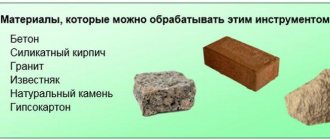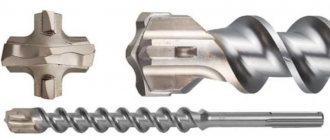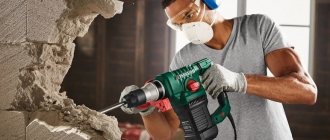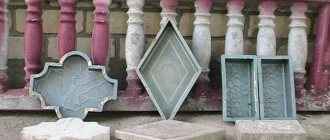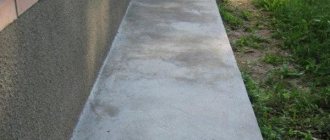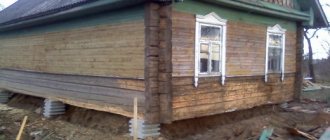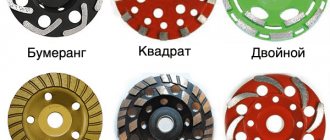During construction or renovation, it is often necessary to drill holes in concrete and stone with a hammer drill. In order for the drilling process to proceed quickly, it is necessary to select the correct concrete drill for the hammer drill. Many people mistakenly think that they can make holes in such material with simple drills. But in fact, during the drilling process, ordinary consumables quickly bend and become dull. This article will discuss the criteria for choosing a drill for a hammer drill. To make it easier to understand, the most popular blastholes from well-known world brands will be listed today.
Types of boreholes
Drill and drill: what is the difference
A drill differs from a drill in that it drills holes through impact-rotational movements. Thanks to this, it is possible to make deep holes (up to 1000 mm) in high-strength structures, which are extremely problematic and often impossible to drill with conventional drills.
True, in the process of such drilling it is often necessary to make reciprocating movements to extract dust from the hole being made. The hole tip is generally equipped with a crown (most often consisting of several cutting segments), which significantly increases its service life.
Important! The most important thing is that the drill does not bite while drilling concrete, otherwise it will break or jam. To extract a hole, some types of hammer drills provide reverse operation. It is also necessary to regularly lubricate the shank so that it wears less.
The drill differs from the drill and has a shank (the part fixed in the chuck). The drill is mainly fixed by movable cams. A special cartridge with locking balls is provided for drill holes. Today, drills with a chiselling function are sold on the market, but they are ineffective in working with hard materials.
SDS Plus Size Chart
Design features of a drill bit, what they look like
Before starting the work, the master determines which drill to use to drill the concrete. If used with a drill, the base will be round or hexagonal. No side grooves are made here due to the fact that this is not necessary. They are required when the master will work with a hammer drill, and are designed for stronger fastening of the part.
For drilling in monolithic slabs, a pobedit tip is used. It retains its sharpness for a long time even with intensive use. Pobedit is an alloy of tungsten and cobalt, with very high strength.
Note! Drilling with diamond bits is used to create recesses. They are cylindrical in shape and made of hardened steel, mounted on a rod to be secured in a chuck. The working edge can be smooth or serrated. To increase its strength, diamond coating is applied to it.
Using diamond drills is more expensive than conventional tools, but provides better results. When using such a tool, even the most durable types of concrete will be drilled quickly. The resulting holes will have smooth edges. When the master works in this way, the formation of dust and debris is almost completely absent.
Types of concrete drills for rotary hammers
They differ in some important parameters, which are discussed in detail below.
Shank size
There are 5 types:
- SDS - shank with a diameter of up to 10 mm with two grooves.
- SDS plus is the most common size used in household hammer drills. It is characterized by a diameter of no more than 25 mm. There are four grooves for fixing it.
- SDS-max - shank with a diameter of up to 80 mm, used in industrial units. For fixation, it uses three open and two closed grooves.
- SDS-top is an intermediate shank size with a diameter of 16-25 mm, used in some BOSCH power tools. It has 4 grooves for good fixation.
- SDS-quick is a hex shank with a diameter of 4-10 mm, designed for Bosch Uneo/Uneo Maxx rotary hammers. It uses dowels for fixation.
Diameter and length
These are the most important dimensions of the drill, so you should definitely pay attention to them during selection and purchase.
- Diameter. Depends on the length and type of shank - for example, the maximum permissible hole Ø SDS max is no more than 50 mm. It is expressed as an even number.
- Length. The maximum drill length for a rotary hammer is 1000 mm, and the minimum is 100 mm. In production, the most popular drills are Ø 18, 20, 22, 24, 28 and 32. The drilling procedure does not allow the use of longer holes - it is impossible to drill holes with them.
The length of the drill depends on its diameter. These characteristics must be balanced so that deep holes can be drilled efficiently and safely.
The article contains tables showing the length and diameter of drills produced today.
Size Chart SDS Max
It should be noted that the longest drill for rotary hammers in accordance with the latest table is 1320 mm.
Resource (durability)
Experienced installers drill a large number of holes in various structures every day, so the working surface of the hole quickly wears out and its productivity is lost. The durability of a concrete drill for a hammer drill mainly depends on the metal used in its production.
In particular, much depends on the quality of the soldered crown, which is responsible for the main function of the drill (destruction of solid material). If necessary, you can use a drill to drill holes in wood products.
Attention! When choosing a drill hole, you need to take into account its main performance characteristics so that you do not have to subsequently purchase a new one and spend additional money.
How to drill concrete
To choose what to drill into a concrete wall, you need to follow the rules:
- Choose a tool with the ability to change the speed of the process, thanks to this the drill will work carefully without damaging the surface.
- Pay attention to whether the tool has impact drilling and depth adjustment; this gives good results when working with problem areas and helps soften them.
- Choose a drill that you can hold with both hands.
- Pay attention to the power of the tool.
Drilling with a hammer drill
The hammer drill is the most powerful tool, suitable for large volumes of work and for drilling concrete walls.
There are 2 ways this tool works: rotation and impact. For rotation, a special type of drill bit for a concrete hammer drill is used - a drill, it comes with a Pobedit drill bit. You can tell what a concrete drill looks like by its special shank, to which a special chuck is installed.
Such drills mean:
- SDS plus - has a thin shank and recesses to hold the hammer drill in your hand, the profile is symmetrical, it is easy to install this type of drill;
- SDS max - has a thick and long shank; correct installation is possible only in one position.
The pobedit tip is resistant to heavy loads. When the hole is located on the edge of the structure, drilling concrete using the impact method is not recommended, because A concrete structure may chip, and when working with ceramic tiles, the material will simply crack.
In this case, it is better to use a diamond concrete drill for a hammer drill; it has greater hardness than a Pobedit drill; you must take breaks during work to cool it; drilling at high speeds is prohibited.
Do not use hammer drilling with a diamond drill, as... Although it has great hardness, it is highly brittle and can crack.
Drilling
For small-scale work, especially in an apartment with thin walls, you can make a hole with a drill designed for drills for working with concrete. It can be either a win or a diamond product. A drill with a cylindrical shank is used for impact drills. When working, it is recommended to choose medium speed. Which drill bits for concrete are best to choose depends on the type of drill.
The best drill bits for a concrete hammer drill: rating
Listed below are the most popular drill bits for household and industrial hammer drills today. Thanks to this rating, you can choose effective and durable blast holes for them.
DeWALT EXTREME 2 DT7935B-QZ
Set of 10 drills (USA) in a convenient case with a latch. The drills have an SDS-plus shank, a diameter of 5-12 mm and a length of 110-160 mm. They are designed to work with stone, concrete and brick. Capable of working flawlessly for a long time with proper care.
Intended for household use. It is worth noting that this set is inexpensive.
Set DeWALT EXTREME 2 DT7935B-QZ
BOSCH 3.5×50/110 mm
The drills are distinguished by high quality workmanship and durability. This drill with an SDS+ shank allows you to quickly carry out construction and repair work in a house or apartment.
The cutting segments of the drill bit are made of high quality, so it allows you to make holes in stone, brick and concrete without any problems.
BOSCH 3.5×50 – 110 mm
Granite 425100 25/1000 mm
Has an SDS-plus shank. It uses four cutting segments and a double spiral for high-quality dust removal. It is made of high-alloy steel, and is subjected to hardening. Thanks to this, the service life of the product is significantly increased.
For reference! Due to high demand, it is difficult to find on the domestic market.
Granite 425100 25/1000 mm
Makita D-00050 /100 mm
This drill is designed for household power tools with SDS-plus chucks. It uses two carbide cutting edges, so the process of drilling the material is more uniform and faster.
The drill tip is well centered, due to this, drilling takes place exactly in the given direction. Thanks to the use of this tool, vibration is practically not felt during drilling.
Makita D-00050 −100 mm
Granite Quadro-X 845570 45/570 mm
Designed for industrial hammer drills with SDS-max chucks. Its cutting bit consists of four cutting parts made of high-alloy metal. Thanks to this, the drill has increased wear resistance.
It has a double spiral, due to which the destroyed material is quickly discharged out.
Granite Quadro-X0 mm
Thanks to this rating, the reader will no longer have the question of which drill bits are best for rotary hammers today.
With the help of this article, you can quickly select the optimal drill for a household and industrial hammer drill, and then at any time make the required number of holes in walls, floor slabs and other structural elements of buildings and structures. The most important thing in the drilling process is to adhere to drilling technology and safety precautions so as not to get injured or break the tool used in the work.
Distinctive features of concrete drills
You can simplify the task of identifying a drill for concrete if you familiarize yourself with its features before choosing:
Tip shape:
- If the drilling device is intended for working with wood, then there will be a point at its tip that makes it easier to enter the wood;
- A special feature of metal drills is the presence of a cone-shaped tip that does not have a point;
- A drill for concrete must have a blunt tip, on which there is a plate made of pobedite.
According to the size of the angle between the cutting edges:
- for steel – 140 degrees;
- for duralumin, brass, bronze - from 110 to 120 degrees;
- for copper, soft aluminum, wood, plastic - from 90 to 100 degrees.
By color:
- A metal drill must be made in black;
- It is customary to design a wood drill in a medium metallic shade;
- The concrete drill has a white metallic color.
Nowadays, many different devices and tools are used to carry out the necessary construction work. One of the very first was a drill. Holes for various purposes remain in demand today: to hang a picture, lay a wire, assemble and attach furniture, secure a baseboard and much more. For each material in which you need to make a hole, you need to use a drill bit suitable for that material. So what types of drills are there?
Content
- Classification of drills video
- Design of the working part
- Shank design video
- Materials for making drills
- Drill Coatings
- Different materials - different drills
- We work with metal
- We drill wood, plywood, chipboard and plastic
- Drilling concrete and brick
- Other materials
Drill classification
The drill has been used by people for more than two thousand years. During this time, it has come a long way from a simple wooden stick to a high-tech product.
Conventionally, each drill is divided into three parts:
- working part;
- neck;
- shank.
Drills are classified according to several criteria:
- design of the working part;
- shank design;
- by manufacturing method;
- by appointment;
- according to the material being processed;
- by drill coating.
Design of the working part
The working part of the drill is selected depending on the material in which the hole needs to be drilled:
Spiral or screw drills are the most popular and common, familiar to every average person. The working part of the drill consists of two cutting edges, which are formed by the intersection of two helical surfaces. At the tip of the drill, the edges form an angle - depending on the material being processed, its value changes. For soft metals and wood it is 80-90°, for steel and cast iron - 116-118°, for stone, concrete, brick - 130-140°. One of the varieties of twist drills is deep drill bits. Technological holes are soldered or drilled into the tool to supply coolant to the working area.
Flat (feather) drills - used for drilling holes in wood and plastic. The cutting part, made in the shape of a blade, allows you to drill holes of large diameter and depth.
Annular drills - made in the form of a hollow cup, the material is selected only along the perimeter of the drill.
Centering - used when drilling center holes. They are divided into four types: A, B, C, R. The type of drill depends on the sharpening angle of the drill and the presence of a safety cone. They are used for drilling shallow holes for further processing.
Single-cut drills – designed for drilling precise holes in metal. Often used in weapons production. The drill is made hollow. The chips, along with the coolant, are discharged through a technological hole in the drill, which ensures high drilling accuracy. Used for drilling long and short holes. Provides low surface roughness. When working with this drill, it is recommended to rotate the tool quickly and slowly rotate the part in the opposite direction.
Conical drills – designed for drilling in sheet metal up to 4 mm thick, various plastics, glass. The drills do not require preliminary centering and have a smooth cutting part.
Step drills - used for processing sheet metal, plastic, glass, marble. They have increased wear resistance of the cutting part and an extended service life. With their help, centering, drilling and deburring are performed in one go.
Forstner drill - used for drilling holes in wood, plastic, and drywall. As a result of using this tool, accurate holes with the correct geometry and clean, scratch-free holes are obtained. These drills are equipped with four cutting surfaces: two main cutters and two scoring ones. Ideal for drilling blind holes with a flat bottom.
Multi-sided hole drills - used for drilling three-, four-, five- and hexagonal holes. The number of teeth in these drills is always one less than the number of edges of the hole.
Shank design
Drill shanks also have differences; let’s look at the shank designs.
Cylindrical shank - used on all types of drills. In most cases, the diameter of the shank is equal to the diameter of the drill. Transmits little torque due to possible slippage in the chuck.
Conical shank (Morse taper) - used in industrial tools for securing in machine tool chucks.
Triangular shank - drills are easily clamped with a three-jaw chuck, eliminating rotation of the drill in the chuck.
Square shank - a drill with such a shank is inserted into a hole of the appropriate shape. Nowadays it is practically not used due to poor fastening in the three-jaw chuck.
Hexagonal shank - easily secured in the chuck and prevents tool slipping. Based on it, a special ¼-inch holder has been developed for quick tool change. The disadvantage of the shank is that it reduces drilling accuracy when the tool is installed in a ¼-inch holder rather than in a chuck.
SDS (Special Direct System) - shank developed by Bosch. This is a specially designed spline system for quick tool changes. Tools with SDS shanks are called drills. The company has developed 5 types of shank:
- SDS – shank with two grooves, fully compatible with SDS-plus.;
- SDS-plus is the most common SDS type shank. It has four grooves with which it is fixed in the cartridge. Shank diameter 10mm. Suitable for use in all light construction hammer drills. The maximum drilling depth of drills is up to 1 m, diameter – up to 26 mm;
- SDS-top - designed to solve the problems of failure of drills of the SDS-plus system when drilling holes of 16-26 mm. The shank is made with a diameter of 14 mm, which increases the reliability of the drill. To install an SDS-top system drill, you need to change the hammer drill chuck.
- SDS-max – shank diameter 18mm. Used in heavy hammer drills when drilling holes with a diameter of 20mm or more.
- SDS-quick – introduced in 2008. Instead of grooves, protrusions are used in the shank. Used for Bosch Uneo rotary hammer. Compatible with ¼" holder.
Materials for making drills
Drills are made solid or welded. For small diameters up to 8mm, drills are made in one piece. Drills of larger diameter are welded. The drill shank is made from carbon steel, and the cutting part is made from:
Carbon steel (U8, U9, U10, U12) – for drilling wood, plastic, soft metals.
Low-alloy steel (X, B1, 9ХС, 9ХВГ) – used for the same materials, but has increased heat resistance (up to 250°C) and the ability to increase cutting speed.
High speed steel (HSS) – used for drilling unhardened steels. They have high wear resistance and heat resistance (up to 650°C).
Drills with hard alloy (T15K6, T5K10, VK3, VK8) – drills with soldered hard alloy plates. They have great heat resistance (up to 950°C) and wear resistance. Used for drilling concrete, stone, tiles, non-ferrous metals, non-hardened steels.
Carbide drills (VK6, VK8, VK10M, VK15M, T5K12V) are made from steels containing tungsten carbide, titanium and cobalt. Used for drilling high-strength and hardened metals, non-ferrous metals, cast iron, stone, concrete. Drilling is carried out at low speeds.
Drill Coatings
To improve the mechanical properties of drills, they are coated with various materials that help increase their strength and wear resistance.
The following are used as coatings or soldering for the cutting part:
Black oxide film – provides the drill with protection against corrosion and increases the heat resistance of the drill.
Titanium nitride (TiN) is a ceramic material with a golden or yellow-brown color. The coating is obtained by vacuum plasma melting. Increases the service life of the drill by 3-4 times. Drills with this coating cannot be sharpened.
Titanium-aluminum nitride (TiAlN) is a violet-black coating that has heat resistance up to 950°C and high hardness.
Titanium carbonitride (TiCN) is a bronze-violet coating, the shade depends on the amount of carbon in the coating. One of the best coatings for cutting tools.
Borazon is a soldered tool based on boron carbide, which is inferior in hardness to diamond, but has greater heat resistance than diamond. This allows you to increase the cutting speed and processing of the material.
Drills (drills) equipped with diamond – diamond-tipped drills are used for drilling tiles, glass, crystal, ceramic tiles, and stone. When working with a diamond-tipped drill, you should remember that there is increased heat generation in the cutting area, which can lead to damage to the tool or the workpiece. To remove heat, it is necessary to use coolant (cutting fluid). Diamond-tipped drills are highly productive and require almost no sharpening.
Different materials - different drills
This principle has become fundamental in materials processing. Let's consider where, what and how to use it.
We work with metal
In most cases, screw drills are used for drilling metal. They do an excellent job of this task. The drill is selected taking into account the metal in which the hole needs to be drilled. This could be a drill made from low-alloy steel, or maybe from a carbide material. For thin sheet workpieces, step drills can be used.
We drill wood, plywood, chipboard and plastic
Metal drills are also suitable for drilling holes in wood. True, this does not guarantee the accuracy of the task. For precise and high-quality processing of wooden surfaces, screw drills with a special centering tip and feather drills are used. The Forsner Drill has also been developed for blind holes.
Drilling concrete and brick
The construction industry uses drills with an SDS shank - the so-called drills. Since concrete holds compressive loads well, drills for concrete and brick work with shock-rotational movements, thus chipping the material and increasing the speed of work.
Other materials
Glass, tiles, ceramic tiles, and crystal are fragile materials; drilling into them should only be done by rotating the tool. Diamond-tipped drill bits are used for drilling.
To drill large-diameter holes, use a ballerina - a special drill for tiles.
The industry also produces universal twist drills that can be used for various materials. Of course, no one will work with them professionally, but minor repairs in the apartment can be carried out.
Author: Sergey and Svetlana Khudentsov
0
How to distinguish a metal drill from a wood drill?
When making a variety of products, it often becomes necessary to create holes in them. Metals, plant materials, and stone are used as starting materials. Therefore, it becomes necessary to distinguish drills for metal from drills for wood.
It is easy to distinguish a tool by the type of cutting edge. Drilling accessories designed for steel and alloys have pointed angles that allow them to be inserted into the body of the part. For wood, you need to use cutters that remove small chips of wood with each movement of the cutting blade in a circle.
In metal technology, it is customary to consider the process of cutting a material by introducing a wedge into it.
Cutting by introducing a wedge into the thickness of the material: α – angle of sharpening of the wedge (angle at the apex); h – cutting depth; l – chip separation length; l₁ – length of chip twisting; d – width of the blasting surface
- It is assumed that the wedge itself is made of a hard substance that is stronger than the body being penetrated. Therefore, only the processed object is destroyed.
- The movement of the wedge is carried out due to the applied force P. It is sufficient to have a destructive effect in the contact zone.
- The sharpening angle α is less than 90⁰, so cutting into the material is possible.
- The wedge has two surfaces: one faces the material being cut, which is why it was called the front; the other is adjacent to the workpiece, it is called the back.
- During the destructive action, chips are formed. Depending on the plastic properties of the workpiece, it can: break into separate fragments; chip away while maintaining a single body; to be twisted, twisted.
The cutting process is characterized by the following parameters:
- h – cutting depth, mm (for different types of tools this value is determined in different ways);
- v – cutting speed, m/s (it is customary to consider linear movement inside the cut chip per unit of time);
- s – feed, mm/rev (a criterion characterizing the productivity of the cutting edge penetration into the workpiece).
When developing a technological process for processing materials by cutting, the main parameters are calculated. From these they are further determined:
toper – the duration of the actual time required to remove the layer by cutting, min;
tpiece – piece time is calculated to determine the actual costs of a technological operation, min.
Elements of a metal drill
For metal, drills made of high-speed steel are used, as well as with overlay plates made of hard alloys. They are marked:
- R6M5, R9, R18 - different versions of high-speed steel. Its main feature is the possibility of self-hardening during cooling after completion of work;
- T5K6, T15K8 – carbide surfacing for drills on hardened steel. They are used to make holes in metal having a hardness of HRC 45...50;
- VK6, VK8, VK12 – drills with carbide tips for cast iron. They can be used to drill holes in the presence of shock loads.
Cutting edges of a twist drill for metal
A distinctive feature of a tool designed to make holes in metal parts is the presence of several cutting edges. It's easy to identify them:
- jumper. It is located between the main blades;
- two main blades. For different types of metals, they create their own sharpening angle;
- the ribbons are two spiral edges. Their task is to form the inner surface of the hole.
When sharpening, an angle is formed between the two main blades in a special way.
Drill sharpening angle
Wood drill cutting edges
For wood, a different type of drill is used. The most widespread are perks (feather drills). The main difference is this:
- there is a special cone that defines the center (in some designs a conical spiral is created here);
- sharp triangles along the periphery specify the drilling diameter;
- the two main cutting edges are perpendicular to the axis of rotation.
Wood drill bit
When the hole depth is shallow, there is no need for surfaces to remove chips from the holes. Due to centrifugal force, waste flies out.
Drilling and reaming
The drilling process has certain differences from other operations. This is where the tool itself rotates. At the same time, it is embedded inside the part.
Drilling and hole reaming
Possible options:
- drilling, this process is characterized by the creation of a new hole;
- reaming is an operation to increase the diameter of a hole.
When metal is processed, the heat generated is distributed:
- on the cutting edge of the drill;
- for heating the chips;
- to heat the entire workpiece.
Quite a large amount of heat is released. It usually accounts for up to 50...60% of the total energy spent on the operation. Therefore, when working with steel and other alloys, they try to remove heat. Lubricants and coolants are used.
It is customary to distinguish processes by depth. If the hole is drilled to 4...6 diameters, then it is assumed that normal drilling is being performed. If you need to get a hole in which the depth is more than 6 diameters, then such an operation is called deep drilling. Here it is necessary to supply coolant to the cutting zone.
Drilling wood
When doing woodwork, note:
- the chips practically do not heat up;
- the body of the part itself has local heating only in the place where the cutting edge comes into contact with the material being processed;
- The edge gets very hot, there is practically no heat dissipation.
Drilling wood. The resulting chips do not heat up
When working with wood, coolant is used extremely rarely. Only wood boards impregnated with polymer resins can be treated with lubricants and cooling. Delta wood, which was previously used to make aircraft, was drilled using coolant. In those processes, the need was determined by the high productivity of labor at aircraft factories.
Main types of wood frames
Considering the design of the tool, you can note the difference:
- the twist drill does not have a pronounced ribbon, but has a sharp cone for penetration in a given direction;
- For deep holes I use the Lewis spiral design. It only has one main edge. She crashes into the part. During operation, the spiral itself is pressed tightly against the walls, so moving to the side is impossible;
- Forstner drill is used to make shallow holes. A similar tool is used on filler machines, where recesses for fittings are made.
Is it possible to drill wood with a metal drill?
Sometimes you can hear the opinion that you should not use metal drills on wood. But in fact they are used quite successfully. They are especially often needed when it is necessary to create holes of small diameter from 2...3 to 8...10 mm.
Combination drills used to produce complex holes contain elements for working with metal. In furniture factories, such tools are quite widespread.
Combination wood drills
In one pass, a hole is made to a given depth. Along the way, a conical recess and a cylindrical recess are processed. To prepare special parameters for confirmation, slight differences are observed.
Drill for confirmation
If it is necessary to make large holes in wooden structures, crowns are used.
Simple crown
Complex crown
Finding out the drilling diameter is easy. It is indicated on the crown itself. For complex types of instruments, remove excess blades before use. They leave only what is required by the task.
It can be seen that in both designs a metal drill is used as a basis. It is installed in the center. Subsequently, the cutting edges of the crowns penetrate the periphery of the hole.
: drills - their types and types.
Conclusion
- Metal drills are made from steel alloys with high hardness. Often when using them, provision is made for the supply of lubricating coolants.
- Different types of drills are used to make holes in wood. They are presented in the form of various designs.

